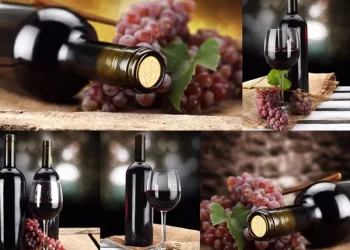When drinking wine, many wine lovers like to taste the wine carefully. Do you know what the ingredients are in the wine?
Water is the largest component of wine, usually up to 70-90%, and plays the role of dissolving and carrying other substances.
In wine grapes, the proportion of skin, pulp and seed is about 20%, 75% and 5% respectively. The most important ingredient in the flesh with the highest proportion is water, which is where the water in wine comes from.
In the process of winemaking, when the grape juice or liquor is separated by pressing, the water is separated from the skins and seeds and becomes an important part of the liquor.
Alcohol is the second largest component of wine by volume, mostly between 9% and 16%.
Alcohol comes from the fermentation process of wine, in which saccharides are converted by yeast, and is measured by alcohol content/alcohol by volume.
The alcohol content of different types of wine generally varies greatly.
From the taste point of view, the alcohol in wine can not only bring a burning sensation to the mouth, but also affect the body of the wine.
In general, wines with a higher alcohol content have a fuller body and a heavier mouthfeel, the more they burn the mouth, especially the throat.
Grape varieties that tend to accumulate sugar, warmer, hotter climates and later harvest times all contribute to higher alcohol wines.
Acid is also a very important component of wine, generally accounting for between 0.3 and 1%.
Tartaric acid, malic acid and lactic acid are the three most important acids in wine. Among them, tartaric acid and malic acid come from grape fruit and are important components of grape flesh.
Lactic acid is the product of malate-lactic acid fermentation, a process in which sharp malic acid is transformed by lactic acid bacteria into a milder lactic acid. Most red and well-aged white wines undergo malate-lactic acid fermentation.
Other types of acids, such as succinate and citric acid, can also be found in wine, though in lower amounts.
Acid is an important factor affecting the taste of wine. Low acid wine generally tastes more smooth and round, while high acidity wine is more fresh and crisp, and its irritation and acidity in the mouth will be more obvious, making the mouth feel refreshed.
If the wine itself is high in alcohol or sweetness, it needs to be balanced by a matching high acidity, otherwise the wine will lack vitality and freshness.
In addition, acid is also one of the important factors to maintain the stability and prolong the life of wine. Wines with higher acidity and balanced structure generally have better aging potential.
Cooler climates or early harvests can help produce wines with higher acidity.
Sugar is another important component of wine, mainly including glucose and fructose.
These sugars come from the ripening process. As the grapes ripen, their sugar content increases and their acidity decreases.
During fermentation, the yeast converts the sugar into alcohol and carbon dioxide. If the yeast converts all of the sugar or leaves no more than 4 grams of residual sugar per liter, the wine is dry.
If, at the end of fermentation, the resulting wine contains more than 45g of sugar per liter, it is considered sweet.
Sugar acts as a sweet taste in the mouth, and the more sugar a wine contains, the sweeter it tastes.
Also, more sugar makes the wine taste fuller and richer.
In white wines, sugar acts as a “preservative” and the more sugar a wine has, the more likely it is to age, given the balance between acidity and sweetness.
To create certain styles of wine, winemakers can increase the sugar content of the resulting wine by interrupting fermentation, concentrating the sugars in the grapes and adding sweet reserves.
Phenols make up a small but important part of wine and include a range of compounds that have a significant impact on the color, texture and taste of wine.
The phenolic substances in wine mainly come from grape fruit, and the peel is the most important source.
In general, red wines are more abundant in phenols than white wines because white wines are pressed before fermentation, while red wines are pressed after maceration and fermentation, and longer skin contact times allow more phenols to be extracted from red wines.
In addition, aging in oak barrels also endows wines with phenols such as tannins.
There are two main classes of natural phenolic substances in wine: flavonoids and non-flavonoids. Tannins and anthocyanins, the two most important phenolic substances in wine, belong to flavonoids.
Tannins are an important part of the structure of red wines. They give the wine a tight and astringent taste and give the wine aging potential. The more tannins in a balanced wine, the more likely it is to age.
Anthocyanins are water-soluble flavonoids that give red wine its color.
Aromatic compounds are the source of the pleasant aroma and flavor of wine, although accounting for less than 0.2%, they are one of the essential ingredients.
Wine grapes contain many compounds that are also found in other fruits and plants, so we can experience similar aromas and flavors from wines. For example, Pinot noir has cherry aromas, and Riesling often has citrus peel.
Wine fermentation process will also release some aroma molecules, the formation of new aroma compounds, these from the grape fruit itself and fermentation process of aroma and flavor is often said to be a kind of aroma and flavor, mostly fresh floral, fruity and herbaceous aroma.
After alcoholic fermentation brewing process will also bring new aroma and wine flavor and aromatic compounds in wine in oak barrels, gives fresh vanilla and toast, such as breath, malic acid, lactic acid fermentation can bring the cream and butter flavor, and can be brought mud aging wine yeast and biscuit aroma, these all belong to 2 kinds of aroma and flavor.
Then, as the wine ages, it interacts with oxygen to create aromas such as coffee, toffee and caramel. As the wine ages in the bottle, compounds interact to give it flavors such as mushrooms, gasoline and honey. These are the three types of aromas and flavors.
Depending on the grape variety, terroir, winemaking process and wine style, different wines will exhibit different aromas and flavors.
In addition to the above 6 class, the most important compounds in wine there is also some other types of compounds, for example, can make the wine tastes more fruity, supple glycerin, artificially added to keep the stability of wine or natural fermentation process of sulfite, and play an important role in the sparkling wine of carbon dioxide, and so on.
It is these various and different compounds that make up the delicious grape wine.
The latest market dynamics at any time to see, please pay attention to.












































